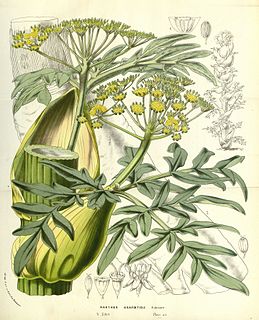
Apiaceae or Umbelliferae is a family of mostly aromatic flowering plants named after the type genus Apium and commonly known as the celery, carrot or parsley family, or simply as umbellifers. It is the 16th-largest family of flowering plants, with more than 3,700 species in 434 genera including such well-known and economically important plants as ajwain, angelica, anise, asafoetida, caraway, carrot, celery, chervil, coriander, cumin, dill, fennel, lovage, cow parsley, parsley, parsnip and sea holly, as well as silphium, a plant whose identity is unclear and which may be extinct.

In polymer chemistry and materials science, resin is a solid or highly viscous substance of plant or synthetic origin that is typically convertible into polymers. Resins are usually mixtures of organic compounds. This article focuses on naturally occurring resins.

Asafoetida is the dried latex exuded from the rhizome or tap root of several species of Ferula, perennial herbs growing 1 to 1.5 m tall. They are part of the celery family, Umbelliferae. Asafoetida is thought to be in the same genus as silphium, a North African plant now believed to be extinct, and was used as a cheaper substitute for that historically important herb from classical antiquity. The species are native to the deserts of Iran and mountains of Afghanistan where substantial amounts are grown.

Silphium is an unidentified plant that was used in classical antiquity as a seasoning, perfume, aphrodisiac, and medicine. It also was used as a contraceptive by ancient Greeks and Romans. It was the essential item of trade from the ancient North African city of Cyrene, and was so critical to the Cyrenian economy that most of their coins bore a picture of the plant. The valuable product was the plant's resin.

Ferula is a genus of about 220 species of flowering plants in the family Apiaceae, native to the Mediterranean region east to central Asia, mostly growing in arid climates. They are herbaceous perennial plants growing to 1–4 m tall, with stout, hollow, somewhat succulent stems. The leaves are tripinnate or even more finely divided, with a stout basal sheath clasping the stem. The flowers are usually yellow, rarely white, produced in large umbels. Many plants of this genus, especially F. communis, are referred to as "giant fennel," although they are not fennel in the strict sense.
Ammoniacum or the gumammoniac is a gum-resin exuded from the several perennial herbs in the genus Ferula of the umbel family (Apiaceae). There are three types of ammoniacum: the gums ammoniac of Cyrenaica, of Persia, and of Morocco.
Sumbul, also called sumbal or muskroot, is a drug occasionally employed in European medical practice. It consists of the root of Ferula moschata, known formerly by the synonym Ferula sumbul, a tall umbelliferous plant of the 'giant fennel' genus Ferula found primarily in the north of Bokhara in present-day Uzbekistan, although its range apparently extends into Southeastern Siberia : beyond the Amur river.

Galbanum is an aromatic gum resin and a product of certain umbelliferous Persian plant species in the genus Ferula, chiefly Ferula gummosa and Ferula rubricaulis. Galbanum-yielding plants grow plentifully on the slopes of the mountain ranges of northern Iran. It occurs usually in hard or soft, irregular, more or less translucent and shining lumps, or occasionally in separate tears, of a light-brown, yellowish or greenish-yellow colour, and has a disagreeable, bitter taste, a peculiar, somewhat musky odour, an intense green scent, and a specific gravity of 1.212. It contains about 8% terpenes; about 65% of a resin which contains sulfur; about 20% gum; and a very small quantity of the colorless crystalline substance umbelliferone. It also contains α-pinene, β-pinene, limonene, cadinene, 3-carene, and ocimene.

Cynaroside is a flavone, a flavonoid-like chemical compound. It is a 7-O-glucoside of luteolin.

Ferula tingitana, the giant Tangier fennel, is a species of the Apiaceae genus Ferula. Despite the name, the plant is not a type of fennel proper, which belongs to another genus (Foeniculum).

Ferula communis, the giant fennel, is a species of flowering plant in the carrot family Apiaceae. It is related to the common fennel, which belongs to the same family.

Peucedanum officinale is a herbaceous perennial plant in the family Apiaceae found mainly in Central Europe and Southern Europe. It is also native to the UK, where it has the common names hog's fennel and sulphurweed, but it is a rare plant there, occurring only in certain localities in the counties of Essex and Kent. It was formerly also found near the town of Shoreham-by-Sea in the county of West Sussex, but has long been extinct there.

Opopanax is a genus of plants in the family Apiaceae.

Sagapenum is a historical plant from Media, identified with Ferula persica and Ferula szowitziana, also denoting its yellow translucent resin, which causes irritation of the skin and whose smell resembles that of asafoetida.

Ferula gummosa is a perennial herb of Ferula in the family Apiaceae. It is native to Iran and Turkmenistan. Its gum resin is called galbanum.

Ferula assa-foetida is a species of Ferula endemic to Southern Iran. It is the source of asafoetida, but its production is confined to Southern Iran, especially the area near Lar.

Ferula narthex is a species of Ferula native to Afghanistan, Tajikistan, northern Pakistan and the Western Himalayan region of India. Although it is often listed as the source of asafoetida, one report stated that its essential oil lacked sulfur-containing compounds which are characteristic of asafoetida.

Ferula persica, the Persian asafoetida, is a species of flowering plant in the family Apiaceae, native to the Caucasus and Iran. It contains a number of matrix metalloproteinase inhibitors.
Ferula drudeana is a species of flowering plant in the family Apiaceae, native to the Adana area of Turkey. It has been proposed as a candidate for the fabled silphium plant of antiquity. It is known from only three locations in Turkey, all sites of longstanding villages. DNA evidence shows that it is in a clade with Central Asian species of Ferula.















